|
By Iain M.M. Johnstone,
author of ‘Viking Place Names of East Lothian’
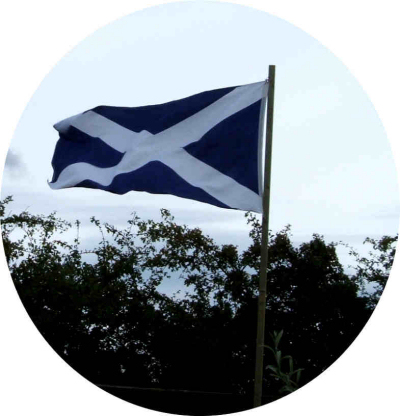
The Legend
Athelstaneford is
a beautiful little village in East Lothian, nestling in the Garleton
Hills, a mile or so from Haddington, the main town of the county. It is
here that it is claimed that the origins of the Scots flag, the Saltire of
Scotland, were occasioned by the results of a famous battle. The story is
that a certain Saxon/Anglic king or prince, Athelstan, was in East Lothian
at the head of a large army, when he came across an army of Scots/Picts
led by one Angus, Hungus, or Oengus.
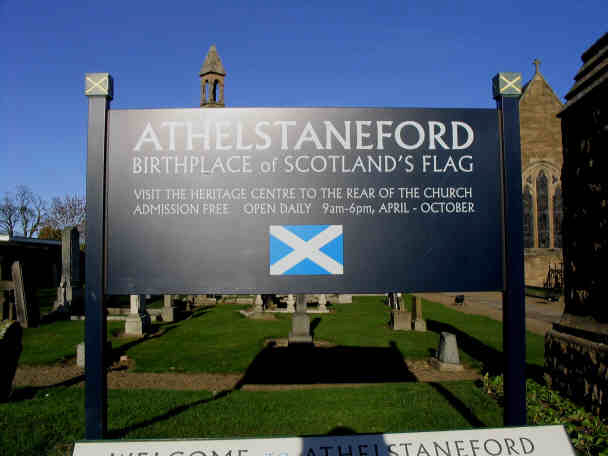
Athelstaneford Church and Heritage Centre
Being surrounded, King
Angus prayed to St Andrew and just before the battle, a saltire appeared
in the sky formed by white clouds against a blue background. This
represented the shape of the cross on which Andrew had been crucified and
seemed a sign from above that the Scots/Picts would prevail that day. It
gave added strength and purpose to Angus and his men and a great victory
followed.
Athelstan’s head was cut
off and displayed on top of a long pole on the little island of Inch
Garvie, Gaelic for ‘rough island’, in the Firth of Forth. Ever after, the
Scots/Picts showed a great devotion to St Andrew and the Saltire became
Scotland’s national flag and Andrew their patron saint.
This was according to
Walter Bower, (1385-1449) a Scots Augustinian monk from Haddington, who
wrote a history of Scotland in Latin called the Scotichronicon, in an
Augustinian monastery on the isle of Inchcolm, Gaelic for ‘Columba’s
island’. St Andrews University had been founded in 1410, and he had been
amongst the earliest students to graduate. He had also been attached to St
Andrews Cathedral. In 1417 he became the Abbot of Inchcolm monastery and
commenced his great work using and building on the earlier work of John of
Fordun, who died in 1384. Bower was the first person to identify this
place with a battle between Picts and Anglians. No mention of Scots. The
present day church in Athelstaneford, built on the site of an older church
founded in the 12th century, by Ada of Northumberland, flies
the Saltire in its grounds and has a history display of the deeds that day
in a 16th century building to the rear of the church.
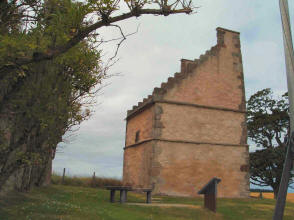
doo'cot
A Gaelic
Alternative
A pleasant tale. Now for
the reality. There is a ‘stane ford’ in ‘Athelstaneford’, and ath el
in Gaelic is a translation. Ath, is Gaelic for ‘ford’ and el,
ail, eil are Gaelic variations of the word ‘stone, rock’. Perhaps it
was meant as a helpful translation for Ada and her Northumbrian train who
would have been grateful for translations of local features in her new
surroundings. I am not the first to suspect this (I thought I was) as the
National Gazetteer for 1868 also proposed this etymology, and no doubt
others, since many people must have read the Gazetteer since then.
Was there an Athelstan who
came to Scotland? Yes, in the 10th century. But he came from
Wessex—and he kept his head. Did a spot of burning, looting and returned.
Some years later he met the Scots again, in the company of Vikings from
Ireland and Scotland, at the battle of Brunanburh (perhaps Bromby, near
Liverpool) in 937—and still kept his head. Tennyson translated a version
of this battle from Old English. The 19th century historian and
etymologist, Skene, claimed that there was a captain or dux from
Northumbria called Athelstan (but no king or prince) and that a battle was
fought somewhere in 832 against an Angus, son of Fergus, king of Picts.
This Angus ruled from 822-834. There was an under-king, Athelstan of
south-east England, who held power from 839-856, according to the
translators of Bower’s Scotichronicon from St Andrew’s University in 1998,
but obviously not a contender. He was mentioned under 836 and 851 in the
Anglo-Saxon Chronicle.
There are three main
sources concerning the origins of the St Andrew legends. The main features
are a person called Regulus comes to Scotland in the 8th
century with relics of the saint, with the purpose of dedicating a church
to Andrew’s memory. He meets Hungus, or Ungus, King of Picts, who gives
him land to build this church, which today is commemorated in the town of
St Andrews in Fife. Skene identifies this Hungus or Ungus with Angus son
of Fergus in the 8th century, who ruled from 731 to 761, and
says he led an expedition against a Northumbrian king named Eadbert (740).
Regulus lived in the 4th
century, was bishop of Patras, took St Andrew’s bones and journeyed to
Scotland with them (he thought Emperor Constantine was going to take them
to Constantinople) and gave them to the Picts who founded a church to St
Andrew... according to some commentators, but there is no evidence he
existed. Plenty of stories, but nothing concrete, just a quagmire of
legends. I find him in no lists of saints in the Catholic Encyclopaedia.
There is mention of a St Regulus, or Reol a Benedictine at Rheims in the
7th century and a St Rieul, companion of 4th
century St Denis, (there is the site of an ancient Chapel of St Denis near
Dunbar which disappeared in the 18th century) in northern
France. There were also a couple of Romans B.C. and a star called Regulus.
That is it. Regulus is a Latin diminutive of rex, regis, and
means, ‘petty or little king’. Hardly the name for a
saint.
What I do find in 4th
century lists of saints is St Augustine of Hippo and reference to the Rule
of St Augustine and the fact that St Benedict based some of his Rule on
Augustine’s letter and sermons that form the base of the Rule of St
Benedict. The Latin for Rule is Regula. St Andrews was governed
according to the ‘Regula or Rule’ of St Augustine, which may well have
inspired the local hermit monks known as ‘Culdees’, which is corrupt
Gaelic, Cill Dia or Dé, for ‘Church or Cell of God’.
It appears likely that some
creative scribe, with poor Latin, has misread some manuscript and come up
with this tale of a St. Regulus. Suffice to say that a devotion to St
Andrew did feature at some point, possibly in the 7th/8th
century, but only really has some substance in the 11th century
when Malcolm Canmore’s second wife, Margaret, who had been born and
brought up as a Saxon refugee at the court of King Andrew in Hungary,
encouraged a devotion to St Andrew and provided ferries for the people to
visit St Andrews.
There is a possibility that
the Picts had relics of St Andrew given to them by someone at an early
stage, 7th/8th/9th century. St Augustine,
not to be confused with Augustine of Hippo, came to Canterbury in 597 from
Rome on the instructions of the Pope, St Gregory the Great, who had
founded the monastery of St Andrew in his home in Rome. Augustine arrived
with forty monks who had, like himself been members of the monastery of St
Andrew. When some years later the English rejected the new religion, the
monks of Canterbury may have retired to the Christian Picts/Scots of the
north. A mere suggestion.
We are on firmer ground
with Eadbert of Northumbria and Angus, king of Picts. According to Simeon
of Durham, 11th/12th century historian and
ecclesiastic, these two had some sort of arrangement whereby they would
turn up at Dumbarton, (Dun Breatann, ‘Fortress of the Britons—yes, the
town should be spelt Dunbarton’) the chief centre of the Britons of
Strathclyde, and exact some sort of tribute or promises from them on the
first of August, 756. It appears to have gone well for them and they
turned to march to their respective homes. Or did they? Nine days after
leaving, Eadbert and his army were decimated, at Niwambirg, leaving
Eadbert to manage home without his army. He then ‘took up the tonsure’
(became a monk) leaving his son to become king—for six months, when he was
killed by his ‘domestics’. This is recorded in the Anglo-Saxon Chronicle.
It was reported afterwards that Northumbria fell into chaos for a hundred
years, with the murder of seven ‘kings’ and six being deposed out of a
total of fourteen. No doubt the situation was not helped by the coming of
the Vikings in 787.
Bede’s Ecclesiastical
History is as reliable a commentary as you can find in those bygone days.
The additions to his History after his death also may carry a fair credit
rating. In 761 the entry records the death of Angus, king of the Picts,
the person who appeared as an ally of Eadbert in 756. Something had
happened. It states, “In
the year 761, Oengus, king of the Picts, died; who, from the beginning to
the end of his reign, continued to be a blood-stained and tyrannical
butcher...”. I think we have here a piece of the jigsaw.
Hoveden, the
12th century historian and chronicler was clerk to Henry II. He takes his
story apparently from a copy of ‘Historia
Saxonum vel Anglorum post obituary Bedae’,
the source of Simeon of Durham, saying that Eadbert and Angus together
led armies to Alclutit (Dumbarton) and mentions Deouama as the place of
Eadbert’s departure and Niwambirg where his army was destroyed.
Considering Eadbert and Angus had been at each others throats for some
years, I think we have the favourite contender, Angus, son of Fergus,
involved in a battle/ambush of Picts against Eadbert’s Anglians, with a
similar result as his ancestor in 685 at the battle of Dunichen—complete
rout of the Anglians, and this time, goodbye Bernicia.
Some people are surprised to
hear of Gaelic place names in the Lothians. In the 9th century
it would have been commonly heard along with Old Norse and Brythonic (Old
Welsh). I’ll come back to that last statement later. Gaelic was actually
the first and only language of a number of people in this area up to the
beginning of the 20th century, according to the Census returns
of this time. Opposite the church in Athelstaneford, there is a path
facing the direction of Haddington. Walk down it for four hundred yards or
so and you will come to a little stream, the Cogtal Burn, which is
overlooked by stone cliffs. Tal in Gaelic signifies a crag or rock
face. Cog is Gaelic for a ‘fifth’, which was a common land measure.
The present day O.S. map has
changed the name of the burn to ‘Cogtail’. No, I don’t know why, either.
For centuries it was ‘Cogtal’, then in the 19th century it was
changed to ‘Cogtall’. I’ve changed it back to its proper name.
The path down to the burn is
made up of large stretches of volcanic rock. Today the burn is crossed by
a wooden bridge and a black Labrador called Rona. In the old days it could
have been crossed by stones. In other words, a ‘stane ford’, in Gaelic,
Ath el. Perhaps it was the Countess of Northumbria, Ada, who had
married Henry, the son of David, king of Scots who had it translated.
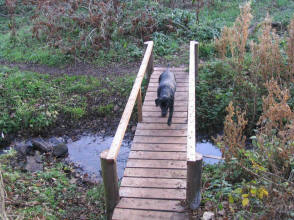
Rona crossing bridge at Cogtal Burn
There are many examples of
tautological couplings (names or meanings that are replicated in another
tongue). Examples are, Knock Hill, Gaelic, cnoc, ‘hill—which is ON
höll’; Broon Hill, Brythonic Broun, ‘hill’; Nungate Road (in
North Berwick), Old Norse gata, ‘a road’.
To summarise, there was one
definite Angus, king of Picts, who was in the company of an Anglian king
and his army in southern Scotland at the same time as the Anglian king
lost all or most of his army and abdicated in order to become a monk.
Whether it was in the area of Athelstaneford may never be known. The
personal name, Athelstan, is a non starter, and his name can easily be
explained by the translation of the Gaelic for ‘stane ford’. There is no
other recorded incident to my knowledge that could provide another
scenario. And that should be that.
An Old Norse
Alternative
Now for a twist in the story.
Ađelsteinn, was and is a common Norse name, meaning the same as Anglian/Saxon,
Ađelstan, ‘noble stone’, with only a difference in pronunciation of the
ending. Norse, Steinn, is ‘stane’ (the common pronunciation in
Scotland) and Anglian, Stan, is ‘Stan- as in stand,
’. But what on earth could this mean in the Lothians of Scotland? There
were no Norsemen, that is Vikings from Norway or Iceland who settled here,
or at least in any numbers to leave a trace. Surely this place had been
colonised by Angles in the 7th/8th centuries and
later gave Scots an Old English base for what is called the ‘Scots’
language?
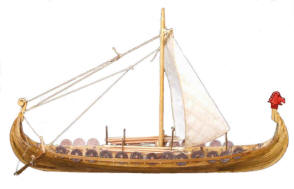
Viking boat
Well, the fact is that the
Norse, as defined above, did settle here in East Lothian and the rest of
southern Scotland, in numbers and left their language as the base for our
early non Celtic Scots tongue—with probably a decidedly Gaelic accent. How
is it a fact?
First and foremost are the
number of words still today in Scots which have no equivalent in English
and do not derive from any other source. Words like Hummell,
‘smooth or rounded’ used of knowes, N. knollr, ‘little hills’;
Whin, name of a county in Norway today, Hvin ,and applied to a
kind of rock all over Scotland; Drook, ‘soak’ from drukna,
‘to drown’. George Tobias Flom, Fellow of Columbia University, U.S.A.,
produced a work in 1900 examining the early Scots tongue in the surviving
works of writers like Barbour, Winton, Lindsay and others. In Barbour’s
Bruce he lists numbers of words of Old Norse (Norwegian) origin that
amazed him at the time and made him question the lack of Old Norse place
names to substantiate his findings. He came up with a list of about a
hundred plus, mostly known to me, and to which I have added hundreds more.
This was in the year 1900. I only read his study and results this year,
2005. It has been well hidden or ignored.
I had already written a
couple of books on place names of Scotland, which had produced for me the
most amazing results. In East Lothian alone, everywhere I looked, they
appeared. And some of them so fantastical that I still find it hard to
believe. These amazing discoveries have been hidden for centuries. Names
like Whittinghame, which Professor Nicolaisen and others reckon to be one
of the three certainties of Anglian settlement in East Lothian turns out
to be pure Old Norse, with a couple of companions straight from the
Voluspo, the Wise Woman’s Tale from the Viking Sagas, lurking next to it.
Incidentally, the ‘spo’ of Voluspo, comes from the Old Norse, spá,
‘to foretell, prophesy’ and gives us the well known spae-wife, ‘a
prophetic woman’ in Scotland. Full details of this and other places are
given in my book, ‘Viking Place Names of East Lothian’, published by
Tarmagan Press, 3 Piershill Place, Edinburgh EH8 7EH. Details at
http://www.scotsplacenames.com/ or
http://www.tarmagan.com/ .
Nearby place names like
Stenton, which was Steintoun, in 1150, according to the Rev. James
Johnston, show its Norse origins and also what became a common and famous
name, Stein, in Scotland. Other names such as Stevenson, from Old Norse,
Stefanson, are recorded in Stevenson House. In the county we have
Gamelshiels and Gumishiels. Shiels comes from Old Norse skjól,
‘shelter, cover’. Gamel is an ON personal name and Gumi is
poetic ON for a man.
In a milieu like this,
Ađelsteinn, would have blended in splendidly with the Old Norse,
Garleton Hills, which abounds with Viking place names.
In my investigation into
Norse customs as well as their language, it became apparent to me that the
Norse had a highly developed sense of humour and a love of doubles
entendres. This would fit in with what seems their policy of
assimilating into the Gaelic and surviving Brythonic cultures they came
into contact with.
For some time before the
Vikings appeared in East Lothian, they had intermarried with Gaels in the
Western Isles and the mainland of Western Scotland. They became known as
Gallgaels, to other Scots, that is, ‘foreign Gaels’. In this area
we have a couple of places named Achingall, which is Gaelic for ‘field of
the foreigner’.
To sum up. There is no
English person called Athelstan(e) in Athelstaneford. A Gaelic translation
of a ‘stane ford’ is a distinct possibility as is the Norse Ađelsteinn
plus ‘ford’, and probably a mixture of the two. Walter Bower reckoned
that the nearby place named Markle, was a corruption of Miracle, a
commentary on the events of that day. The Old Norse have the last word.
Mark, is ON, ‘a wood’ and either hlíđ, ‘cultivated slope’, or
ON, land, ‘land’.
Biography
Iain M.M. Johnstone is a
retired schoolteacher who now lives in East Lothian and has written a
couple of Scots historical novels. |

